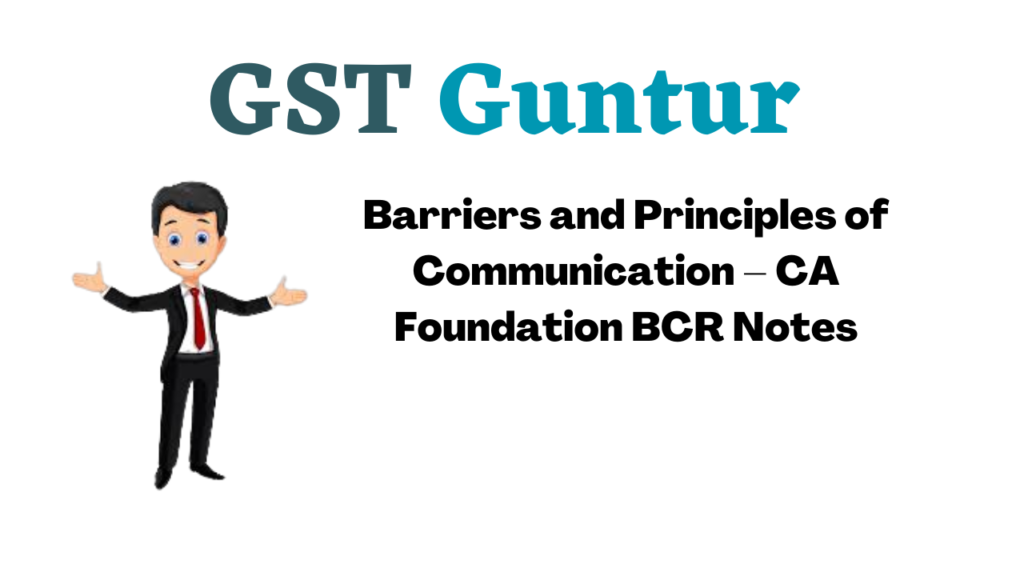Browsing through Barriers and Principles of Communication – CA Foundation BCR Notes Pdf help students to revise the complete subject quickly.
Barriers and Principles of Communication – BCR Notes CA Foundation
Barriers In Communication:
There are several barriers in the process of communication. These barriers cause distortion and misunderstanding. The various barriers in communication may be classified as under:
1. Language or Semantic Barriers:
Difficult words, ambiguous words, jargon (terminology used in a specific field e.g.: medical science), unfamiliar expressions have several meanings. People from different regions and nations may interpret the same words in different ways. When a person with basic vocabulary communicates with an expert in language hurdles arise. Therefore, clear, simple and easily understandable language should be used in communication.
2. Physical Barriers:
These barriers arise due to noise, faulty equipment, distant locations, out-dated technology and lack of good infrastructure.
3. Technology Barriers:
Anyone who is not familiar with modern communication technology (video conference, e-mail, SMS, WhatsApp, etc.) may fail to communicate effectively. Overload of information and an attempt to do several things simultaneously also hamper communication.
![]()
4. Physiological Barriers:
Poor eye sight, difficulty in hearing, ill health and other such problems act as handles in communication.
5. Organizational Barriers:
When the chain of command is unclear, an employee may not know whom to contact for a particular matter. Rigid and ambiguous structure, systems and processes in an organization also hamper effective communication. Unclear roles and responsibilities cause confusion.
6. Cultural Barriers:
People belonging to different cultures derive different meanings from the same message. People working in multinationals have to communicate with persons from different cultures. Lack of understanding of alien cultures inhibits communications. In this era of globalization, it is essential to understand cultural differences. Even within the same organization, employees may belong to different cultures.
7. Gender Barriers:
Men and women often communicate in different ways. Men tend to talk in a logical and linear manner whereas women tend to be more emotional and verbase. Men may blame women for transmitting too much information. Similarly, women may blame men for giving inadequate information. Gender bias is another barrier in communication. Male employees with the traditional mindset may find it difficult to take orders from a female boss.
8. Perception Barriers:
Everyone perceives things in different ways. Two persons may interpret the same event/object differently. Differences in perception lead to miscommunication.
9. Emotional Barriers:
Anger, jealousy, anxiety, lack of trust, fear of criticism and similar feelings/sentiments hinder free and open communication. A disturbed or upset individual can neither convey nor receive information objectively.
10. Attitude Barriers:
A shy introvert, lazy or frustrated worker cannot communicate effectively.
![]()
Essentials of Effective Communication (7CS):
1. Clarity:
The message must be expressed in simple and easy to understand language. Short sentences should be used and each idea must be stated in a separate paragraph.
2. Conciseness:
Only necessary and relevant words must be used. Brevity is the essence of effective communication. There should be no repetitions
3. Completeness:
The message must be complete as omissions of necessary facts creates con-fusion and misunderstanding
4. Concreteness:
Use facts and figures in place of abstract ideas. The message must be expressed in precise words.
5. Coherence:
Different elements of the message must be organised in a sequential and logical way. Words, sentences and paragraphs must be inter connected and there should be smooth flow of information.
6. Courtesy:
The sender of the message must take into consideration the feelings and view points of the receiver. He should be polite, respectful and honest. The message and its tune must not be offensive.
7. Correctness:
The message must be accurate in all respects.
8. Attention and Listening:
The receive must pay full attention to the message. He should not only listen to the spoken words but also carefully observe the speaker’s body language. In case of written messages the reader must read between the lines.
